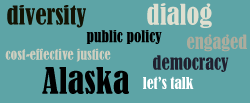September 4, 2015, Alaska Dispatch News
When President Barack Obama arrived in Alaska at the end of August, he found the majesty and beauty of the Arctic. He witnessed the character of Alaska’s adventurous and individualistic people, and the challenges they face in stewarding a land in delicate environmental balance that is also rich in natural resources.
The president also found a state that faces a rather unique budget crisis, with Standard & Poor’s 500 Index threatening to downgrade Alaska’s credit rating [2] if the state doesn’t manage to put its fiscal house in order. He will surely be pressed for help. He should stay clear of this issue, and make decisions based on the state’s and the country’s long-term interests. On fiscal issues, Alaska has all the tools it needs to help itself.
Alaska is not an Illinois and it is certainly not a Puerto Rico. This is a state with relatively high per capita income, even after one adjusts for a high cost of living resulting from Alaska’s climate and geography. This is state where the fiscal problem is that the state cannot figure out how to manage its assets, not that it cannot figure out how to pay its debts.
Alaska has a sovereign wealth fund slightly in excess of 100 percent of state GDP, more than enough to cover both state debt of about 20 percent of GDP (even including local debt) and unfunded state pension liabilities. There is no state income tax and no state sales tax. The overall state tax burden in Alaska is the lowest of the 50 states. On top of all this, Alaska ranks near the very top of all states in federal spending per capita.
The profound fiscal crisis in Alaska comes from a collapse in oil revenues that account for up to 90 percent of the state’s unrestricted general government revenues. Mostly because of sharply lower oil prices, but also because of credits and falling production, state oil revenues have dropped by roughly 80 percent since 2012. Out of total state spending of $8,000 per resident, only $3,000 is covered by revenues, with the other $5,000 basically coming from the state’s Constitutional Budget Reserve fund.
State leaders face enormous political resistance to any kind of new tax, and there are extremely strict limits on how much the state’s wealth fund can be used to cushion the oil revenue shortfall. As a result, the state is madly cutting expenditure, thereby severely aggravating the downturn already caused by the oil price shock. This is an extreme strategy which makes no sense. For one thing, 60 percent of the state’s agency operation budget is spent on education, health and human services. The people of Alaska are its most important long-term resource, and Alaska is very lucky to be one of the states to which people want to move. Dealing with a revenue shortfall solely through precipitous spending cuts is an act of desperation that bankrupt economies are sometimes forced into. It is not sound economic stewardship for a state that has better fiscal fundamentals than most. S&P 500 has rightly argued such an approach is not politically viable, and would require an implausible downsizing of Alaska’s government. More likely, the agency says, Alaska will need to pursue a mix of spending restraint and revenue enhancement.
It’s not as if there aren’t plenty of leading thinkers in Alaska who understand the issues. Gunnar Knapp, director of the Institute of Social and Economic Research at the University of Alaska Anchorage, has traveled the state, giving presentations and laying out options.
One option Alaskans need to dispense with is wishful thinking. The state has been making budget plans based on a long-run rise in oil prices to over $100 a barrel. Yes, oil prices are very volatile and might reach this level, but they could stay below $50 for a long time also. No doubt, many in the state figure new drilling in previously protected wilderness will be a panacea. Setting aside the irony that a state suffering more than most from global warming wants to rely even more on fossil fuel production, the future revenues are highly uncertain in size and timing, especially if oil prices stay anywhere near current levels. Wishful thinking would be fine, except that the longer Alaska waits, the worse the options become.
There is certainly scope to manage the sovereign wealth fund somewhat more aggressively, at the very least the amount in excess of the state’s debt. Other resource-dependent countries like Norway try to strike a balance between risk and return. It would probably behoove Alaska to look at other sovereign wealth funds and how they are managed.
The state cannot rely on good luck alone, and certainly not on smoke and mirrors. With a growing population and shrinking revenues, the time has come to put the state’s finances on a more normal footing by starting to collect taxes like other states that don’t have oil revenues and don’t have any Permanent Fund earnings. By providing more stability and predictability, Alaska will still be able to continue to attract the kind of remarkable individualists it has in the past, and it will certainly have a better chance to make itself into a more diversified economy.
President Obama rightly engaged Alaska citizens and leaders about its future. But as for the fiscal crisis, he needs to let Alaska help itself.
Kenneth Rogoff is a professor of economics at Harvard and former chief economist for the International Monetary Fund. He is the cousin of Alaska Dispatch News owner and publisher Alice Rogoff.

